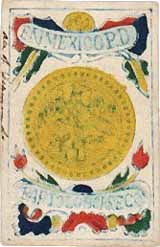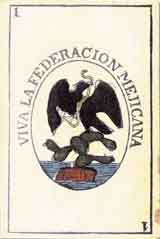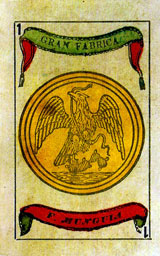Playing Cards from Mexico
MEXICO shares a long tradition with Spain in the field of playing cards and also merges two completely distinct cultures, ancient indigenous cultures and modern Spanish colonialism.
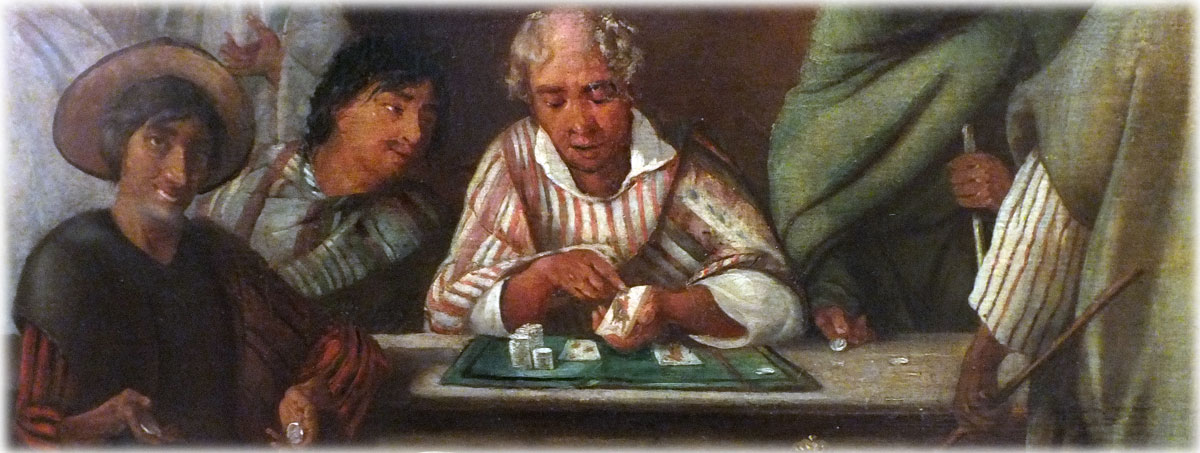
 EXICO shares a long tradition with Spain in the field of playing cards. The early Spanish colonists carried packs of cards with them; thus Mexico inherited the traditional Spanish card suits (oros, copas, espadas, bastos) in the baraja española. Cards were undoubtedly very popular, since prohibitions were passed as early as 1539 and the Estanco de Naipes (playing-card monopoly) was established in 1576.
EXICO shares a long tradition with Spain in the field of playing cards. The early Spanish colonists carried packs of cards with them; thus Mexico inherited the traditional Spanish card suits (oros, copas, espadas, bastos) in the baraja española. Cards were undoubtedly very popular, since prohibitions were passed as early as 1539 and the Estanco de Naipes (playing-card monopoly) was established in 1576.
Mexico belonged to 'New Spain' and formed part of the Spanish Empire. The first printing press was established in Mexico in 1539 by Juan Pablos, who had come over from Italy. Since 1576, a playing card monopoly existed in Mexico. Due to difficulties in finding the materials, the price of cards delivered by the Real Fábrica de Mexico, the monopolist, fell below the acceptable level. In 1583 one Alonso Martínez de Orteguilla was authorised to administer the manufacture and sale of playing cards in New Mexico (which included Mexico, Nicaragua, Guatemala and Honduras). Playing cards were supplied from Seville and France, as well as manufactured in Mexico under licence. By the end of the XVI century over 100,000 packs per annum were being manufactured in Mexico which sold for three reales each and were preferred to those imported from Spain.
From 1777, the viceroy of New Spain determined that cards for Mexico had to be imported from Spain. Until 1811, the Real Fábrica de Madrid cards were sold there. That year, the state monopoly fell.
Mexico re-gained independence in 1821. Local manufacturers were free once again to produce their own cards, although cards also continued to be imported. Initially designs followed the Spanish National pattern and its derivatives. Over time, Mexican card designs have incorporated elements of indigenous art: motifs such as Aztec or Mayan glyphs, symbols, and mythological figures are often incorporated into the artwork. These elements provide a Mexican twist to the classical Spanish layout. Many packs from this period are anonymous and their manufacturers cannot be identified.

F. Munguia commenced producing playing-cards in Mexico in 1868 with the brand names La Campana and La Estrella. A few years later, in 1872, a certain P. Munguia started production, and La Cubana S.A. became the successors of P. Munguia and continued producing the brand names La Campana and La Estrella. Their 1960s catalogue shows an extended range of playing card brands as well as other products.

One of the more influential, and widely plagiarised, Mexican designs has been Clemente Jacques’ “Marca Gallo” playing cards, first published in the 1920s and still produced today by Pasatiempos Gallo S.A. Clemente Jacques also produced the magnificent Naipes Nacionales →

"Los naipes, un juego muy antiguo difundido entre los orientales y los europeos, llegaron hasta América desde los primeros encuentros de las dos civilizaciones. Los navegantes de Cristóbal Colón se entretenían al jugar cartas durante el trayecto del viaje y de igual manera, los pasajeros que viajaron de Europa a las Indias eran jugadores apasionados que se valían de los naipes para matar las largas horas que la nao recorría hasta llegar a su destino.…"
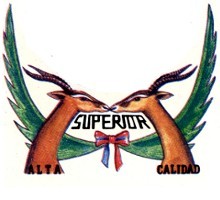

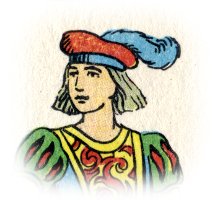
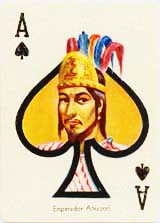

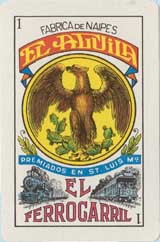



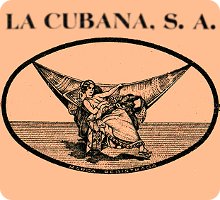
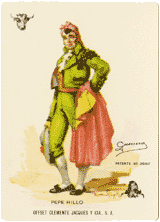
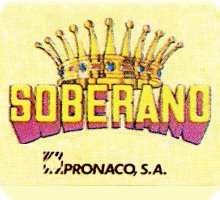
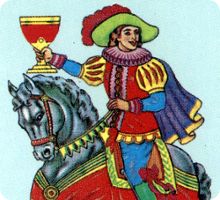
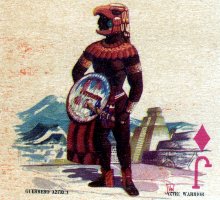
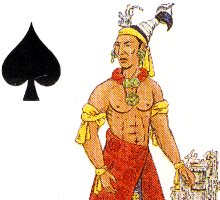
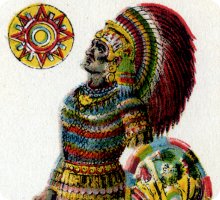
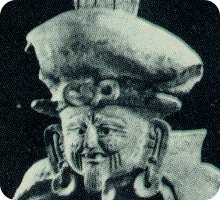
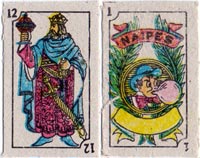
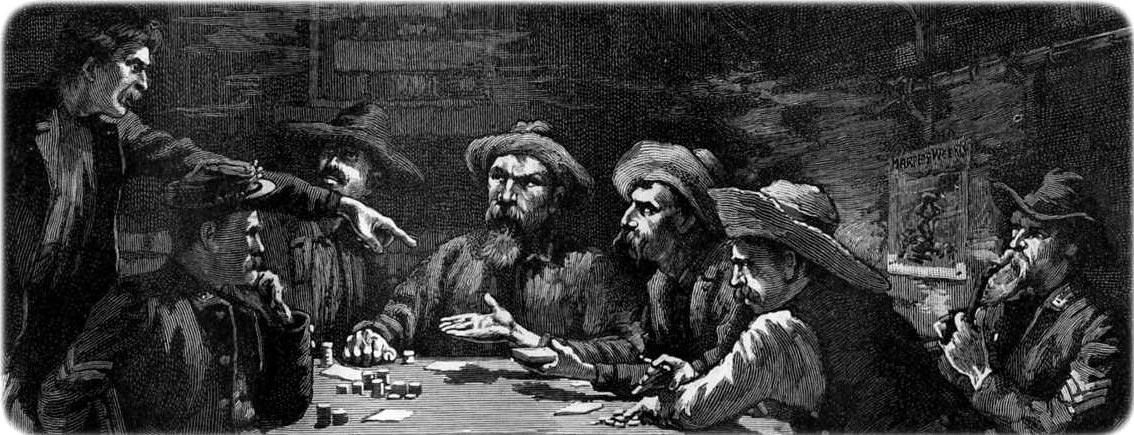
FURTHER REFERENCES:
Cremers, Filip: Belasting is Troef, Nationaal Museum van de Speelkaart, Turnhout, 1992.
García Martín, Enrique: "Clemente Jacques", in LA SOTA no.15, Asescoin, Madrid, September 1996
García Martín, Enrique: "Las Barajas de Símbolos Españoles en América", in LA SOTA no.25, Asescoin, Madrid, September 2001
Grañen Porrúa, María Isabel: "Hermes y Moctezuma, un Tarot Mexicano del Siglo XVI".
Links to other Latin American Countries: Argentina Brazil Chile Colombia Cuba Dominican Republic Ecuador El Salvador Galapagos Guatemala Honduras Panama Paraguay Peru Puerto Rico Uruguay Venezuela

By Simon Wintle
Member since February 01, 1996
I am the founder of The World of Playing Cards (est. 1996), a website dedicated to the history, artistry and cultural significance of playing cards and tarot. Over the years I have researched various areas of the subject, acquired and traded collections and contributed as a committee member of the IPCS and graphics editor of The Playing-Card journal. Having lived in Chile, England, Wales, and now Spain, these experiences have shaped my work and passion for playing cards. Amongst my achievements is producing a limited-edition replica of a 17th-century English pack using woodblocks and stencils—a labour of love. Today, the World of Playing Cards is a global collaborative project, with my son Adam serving as the technical driving force behind its development. His innovative efforts have helped shape the site into the thriving hub it is today. You are warmly invited to become a contributor and share your enthusiasm.
Related Articles

Aónikenk playing cards
Ethnographic playing cards made by members of the Aónikenk culture from Patagonia.

Tarot de Valverde de la Vera
A series of 24 surrealist engravings by Mexican artist Claudio Favier in which archetypal Tarot alle...

Visite Mexico
Promoting Mexican tourism with 54 different photographs in full colour.

Tarot Baraja Egipcia
Curious Tarot with Egyptian-style trumps issued by Franco Mora Ruiz from Mexico.

Mexican ethnic playing cards
Mexican ethnic groups depicted on playing cards by Fábrica de Naipes Cuauhtemoc.

Braulio Fournier
Baraja Nº 1 produced by Braulio Fournier, Burgos, c.1868.

Spanish pattern by Eugène Boisse
Spanish pattern published by Eugène Boisse, Bordeaux.

Santo Mexico playing cards
Santo Mexico playing cards designed by Cédric Volon with Mexico-associated symbols.

Battles in Mexico, 1847
Uncut proof sheet with Mexican Battle scenes on the aces and portraits of American generals on the c...

Colonial Art
A collection of 53 pieces of art showcasing detailed scenes from early American colonial life.

QAIPES – cartas españolas
Spanish-suited cards made in China inscribed “QAIPES” and “BAIPES”!

Naipes Kukuxumusu
A 52-card Spanish-suited advertising pack for a clothing company in Pamplona.

Asha Industries’ Castilian pattern
Colourful Spanish (Castilian) pattern cards made by Asha Industries in India for Mexico.

Calaveras De Azúcar
Calaveras De Azúcar playing cards produced by Natalia Silva, USA, 2017.

Spanish-suited deck by J.Y. Humphreys
A rare Spanish-suited deck published by J.Y. Humphreys, Philadelphia, c.1816.

Mardi Gras playing cards
Mardi Gras playing cards illustrated by Dave Edgerly, USA, 2015
Most Popular
Our top articles from the past 28 days


